Detailed Analysis: Small Business Tax Concessions in Australia
VerifiedAdded on 2021/05/30
|5
|1290
|29
Report
AI Summary
This report delves into the tax concessions available to small businesses in Australia, aiming to provide financial relief and support their operations. The report outlines various concessions, including turnover-based exemptions, which depend on the sales turnover of the business. It covers deductible expenses for start-ups, prepayment allowances, and simplified stock valuation. Income tax concessions, such as reduced tax rates, are discussed, along with the benefits of instant asset write-offs and farm cost deductions. Furthermore, the report examines capital gains tax (CGT) concessions, including the 50% active asset reduction, exemptions for incapacitated owners, and CGT deferrals. Installment payment concessions for 'pay as you go' are also explored, along with the fringe benefit concessions. Overall, the report offers a comprehensive overview of the tax benefits designed to aid small business entities in Australia, based on the provided references.
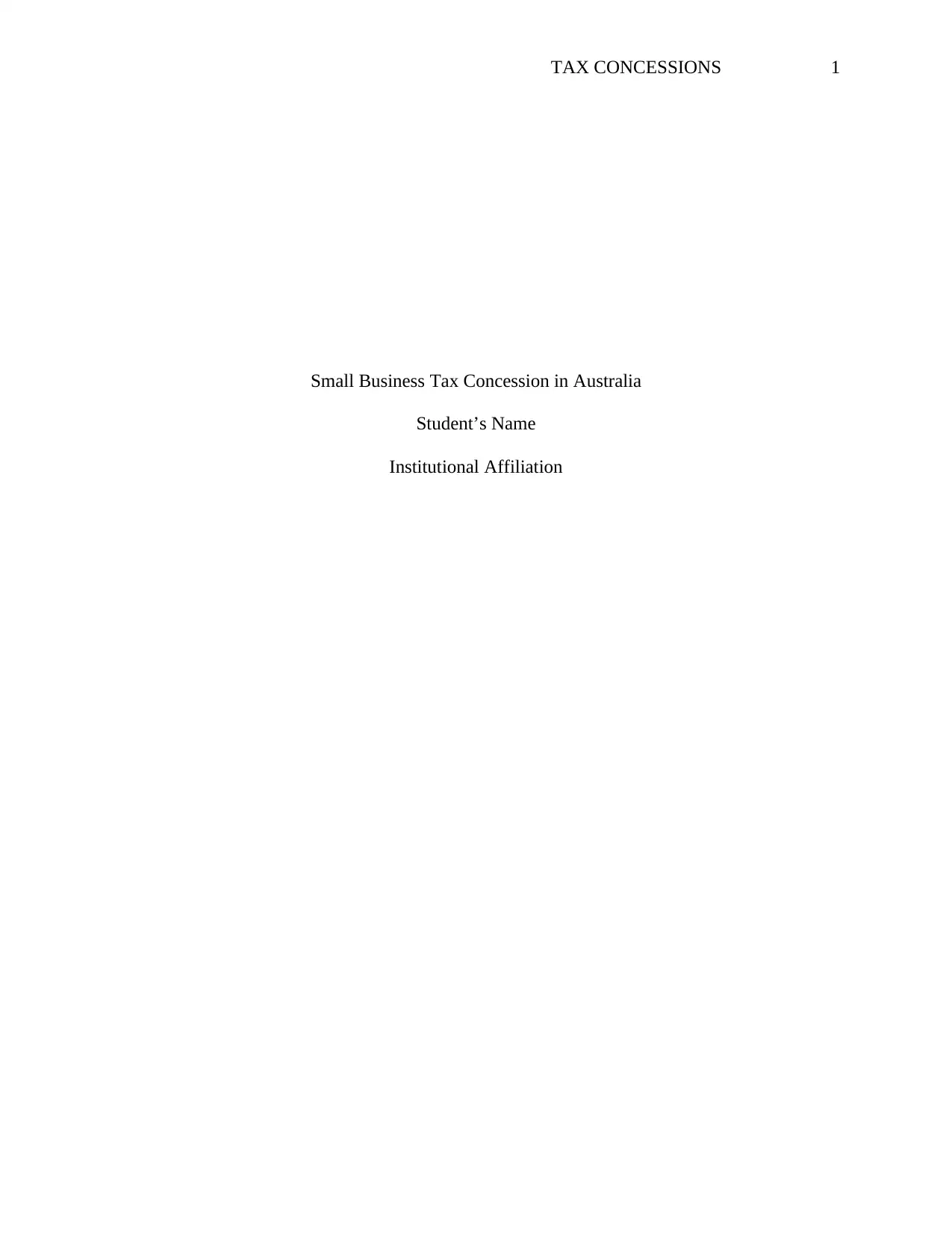
TAX CONCESSIONS 1
Small Business Tax Concession in Australia
Student’s Name
Institutional Affiliation
Small Business Tax Concession in Australia
Student’s Name
Institutional Affiliation
Paraphrase This Document
Need a fresh take? Get an instant paraphrase of this document with our AI Paraphraser
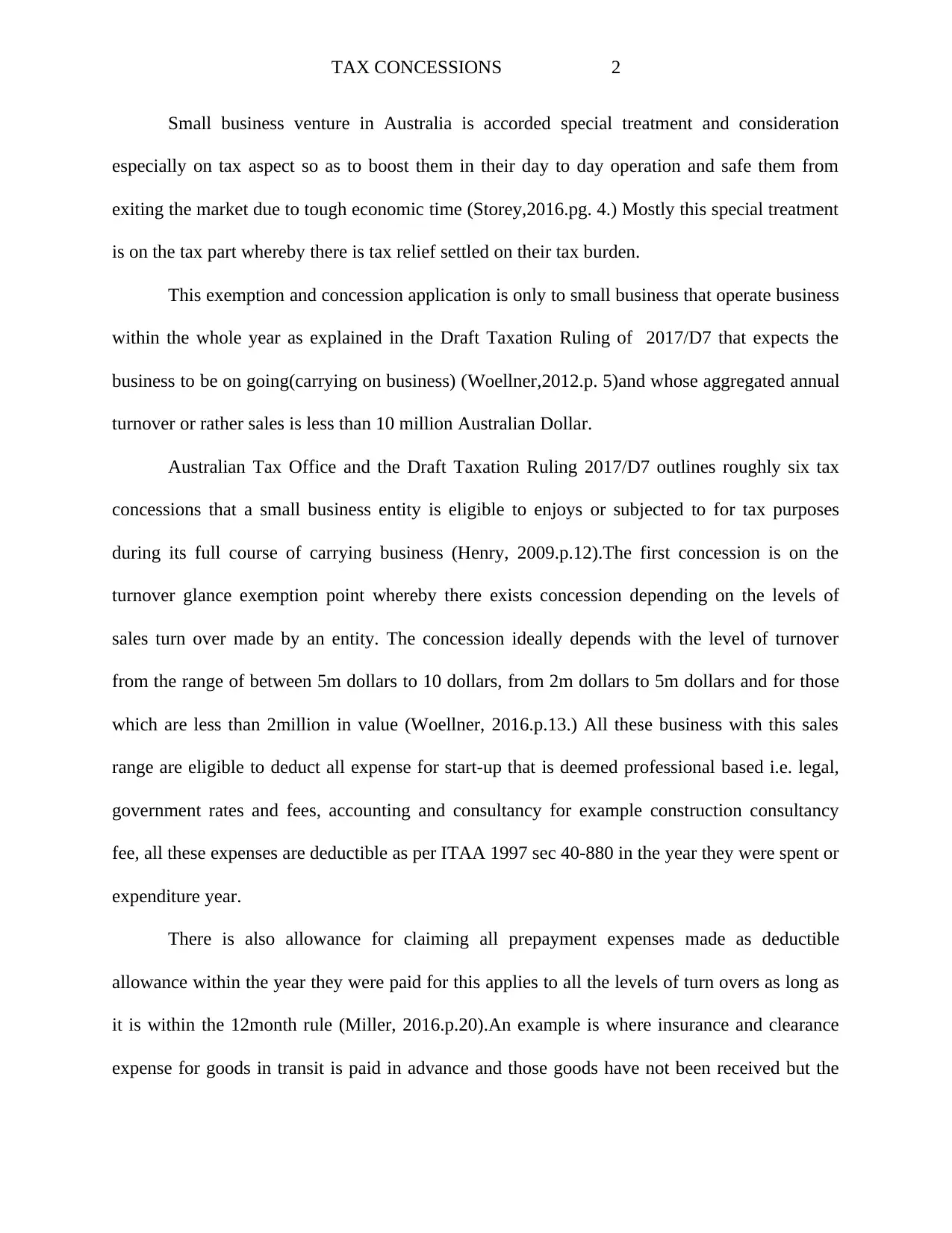
TAX CONCESSIONS 2
Small business venture in Australia is accorded special treatment and consideration
especially on tax aspect so as to boost them in their day to day operation and safe them from
exiting the market due to tough economic time (Storey,2016.pg. 4.) Mostly this special treatment
is on the tax part whereby there is tax relief settled on their tax burden.
This exemption and concession application is only to small business that operate business
within the whole year as explained in the Draft Taxation Ruling of 2017/D7 that expects the
business to be on going(carrying on business) (Woellner,2012.p. 5)and whose aggregated annual
turnover or rather sales is less than 10 million Australian Dollar.
Australian Tax Office and the Draft Taxation Ruling 2017/D7 outlines roughly six tax
concessions that a small business entity is eligible to enjoys or subjected to for tax purposes
during its full course of carrying business (Henry, 2009.p.12).The first concession is on the
turnover glance exemption point whereby there exists concession depending on the levels of
sales turn over made by an entity. The concession ideally depends with the level of turnover
from the range of between 5m dollars to 10 dollars, from 2m dollars to 5m dollars and for those
which are less than 2million in value (Woellner, 2016.p.13.) All these business with this sales
range are eligible to deduct all expense for start-up that is deemed professional based i.e. legal,
government rates and fees, accounting and consultancy for example construction consultancy
fee, all these expenses are deductible as per ITAA 1997 sec 40-880 in the year they were spent or
expenditure year.
There is also allowance for claiming all prepayment expenses made as deductible
allowance within the year they were paid for this applies to all the levels of turn overs as long as
it is within the 12month rule (Miller, 2016.p.20).An example is where insurance and clearance
expense for goods in transit is paid in advance and those goods have not been received but the
Small business venture in Australia is accorded special treatment and consideration
especially on tax aspect so as to boost them in their day to day operation and safe them from
exiting the market due to tough economic time (Storey,2016.pg. 4.) Mostly this special treatment
is on the tax part whereby there is tax relief settled on their tax burden.
This exemption and concession application is only to small business that operate business
within the whole year as explained in the Draft Taxation Ruling of 2017/D7 that expects the
business to be on going(carrying on business) (Woellner,2012.p. 5)and whose aggregated annual
turnover or rather sales is less than 10 million Australian Dollar.
Australian Tax Office and the Draft Taxation Ruling 2017/D7 outlines roughly six tax
concessions that a small business entity is eligible to enjoys or subjected to for tax purposes
during its full course of carrying business (Henry, 2009.p.12).The first concession is on the
turnover glance exemption point whereby there exists concession depending on the levels of
sales turn over made by an entity. The concession ideally depends with the level of turnover
from the range of between 5m dollars to 10 dollars, from 2m dollars to 5m dollars and for those
which are less than 2million in value (Woellner, 2016.p.13.) All these business with this sales
range are eligible to deduct all expense for start-up that is deemed professional based i.e. legal,
government rates and fees, accounting and consultancy for example construction consultancy
fee, all these expenses are deductible as per ITAA 1997 sec 40-880 in the year they were spent or
expenditure year.
There is also allowance for claiming all prepayment expenses made as deductible
allowance within the year they were paid for this applies to all the levels of turn overs as long as
it is within the 12month rule (Miller, 2016.p.20).An example is where insurance and clearance
expense for goods in transit is paid in advance and those goods have not been received but the
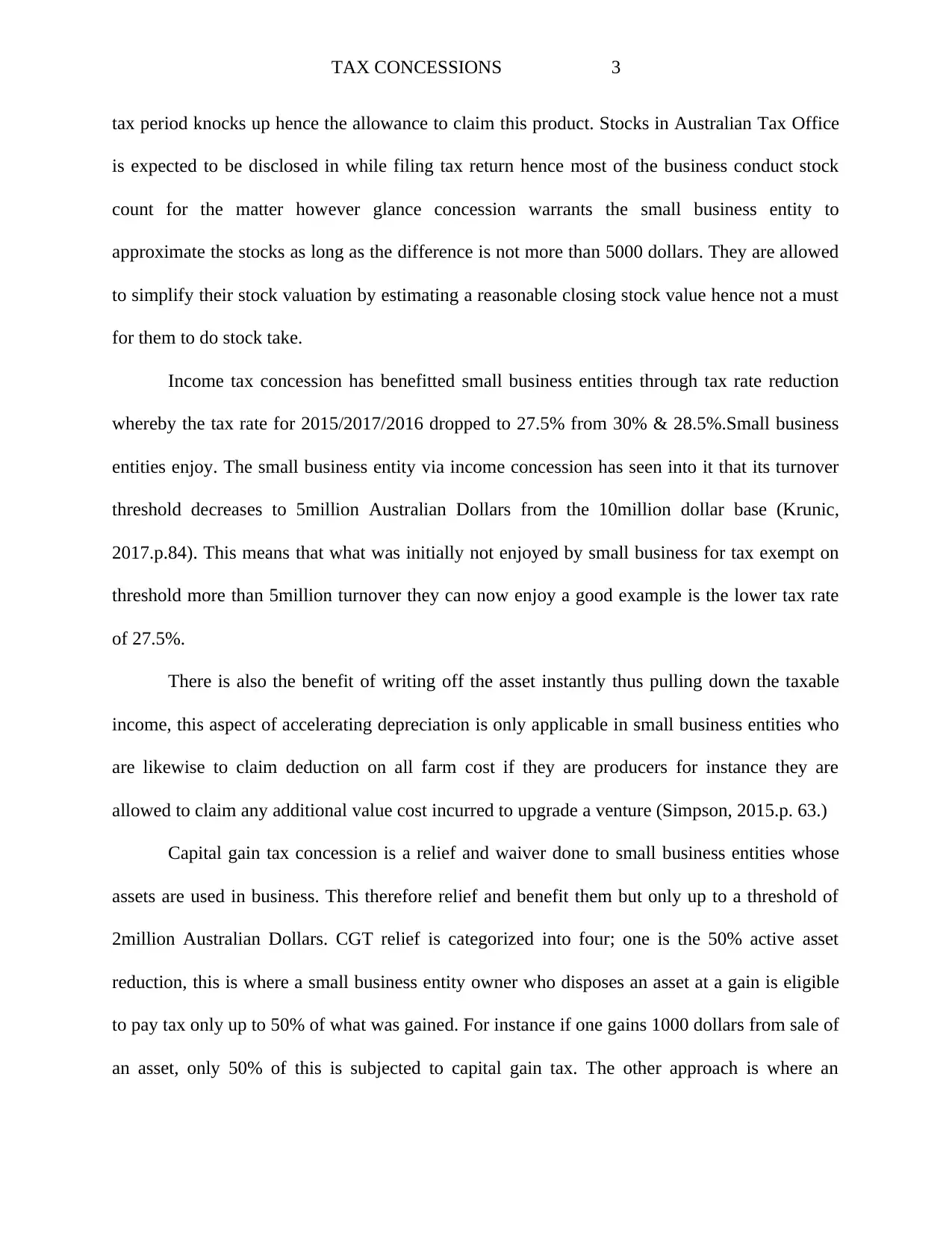
TAX CONCESSIONS 3
tax period knocks up hence the allowance to claim this product. Stocks in Australian Tax Office
is expected to be disclosed in while filing tax return hence most of the business conduct stock
count for the matter however glance concession warrants the small business entity to
approximate the stocks as long as the difference is not more than 5000 dollars. They are allowed
to simplify their stock valuation by estimating a reasonable closing stock value hence not a must
for them to do stock take.
Income tax concession has benefitted small business entities through tax rate reduction
whereby the tax rate for 2015/2017/2016 dropped to 27.5% from 30% & 28.5%.Small business
entities enjoy. The small business entity via income concession has seen into it that its turnover
threshold decreases to 5million Australian Dollars from the 10million dollar base (Krunic,
2017.p.84). This means that what was initially not enjoyed by small business for tax exempt on
threshold more than 5million turnover they can now enjoy a good example is the lower tax rate
of 27.5%.
There is also the benefit of writing off the asset instantly thus pulling down the taxable
income, this aspect of accelerating depreciation is only applicable in small business entities who
are likewise to claim deduction on all farm cost if they are producers for instance they are
allowed to claim any additional value cost incurred to upgrade a venture (Simpson, 2015.p. 63.)
Capital gain tax concession is a relief and waiver done to small business entities whose
assets are used in business. This therefore relief and benefit them but only up to a threshold of
2million Australian Dollars. CGT relief is categorized into four; one is the 50% active asset
reduction, this is where a small business entity owner who disposes an asset at a gain is eligible
to pay tax only up to 50% of what was gained. For instance if one gains 1000 dollars from sale of
an asset, only 50% of this is subjected to capital gain tax. The other approach is where an
tax period knocks up hence the allowance to claim this product. Stocks in Australian Tax Office
is expected to be disclosed in while filing tax return hence most of the business conduct stock
count for the matter however glance concession warrants the small business entity to
approximate the stocks as long as the difference is not more than 5000 dollars. They are allowed
to simplify their stock valuation by estimating a reasonable closing stock value hence not a must
for them to do stock take.
Income tax concession has benefitted small business entities through tax rate reduction
whereby the tax rate for 2015/2017/2016 dropped to 27.5% from 30% & 28.5%.Small business
entities enjoy. The small business entity via income concession has seen into it that its turnover
threshold decreases to 5million Australian Dollars from the 10million dollar base (Krunic,
2017.p.84). This means that what was initially not enjoyed by small business for tax exempt on
threshold more than 5million turnover they can now enjoy a good example is the lower tax rate
of 27.5%.
There is also the benefit of writing off the asset instantly thus pulling down the taxable
income, this aspect of accelerating depreciation is only applicable in small business entities who
are likewise to claim deduction on all farm cost if they are producers for instance they are
allowed to claim any additional value cost incurred to upgrade a venture (Simpson, 2015.p. 63.)
Capital gain tax concession is a relief and waiver done to small business entities whose
assets are used in business. This therefore relief and benefit them but only up to a threshold of
2million Australian Dollars. CGT relief is categorized into four; one is the 50% active asset
reduction, this is where a small business entity owner who disposes an asset at a gain is eligible
to pay tax only up to 50% of what was gained. For instance if one gains 1000 dollars from sale of
an asset, only 50% of this is subjected to capital gain tax. The other approach is where an
⊘ This is a preview!⊘
Do you want full access?
Subscribe today to unlock all pages.

Trusted by 1+ million students worldwide
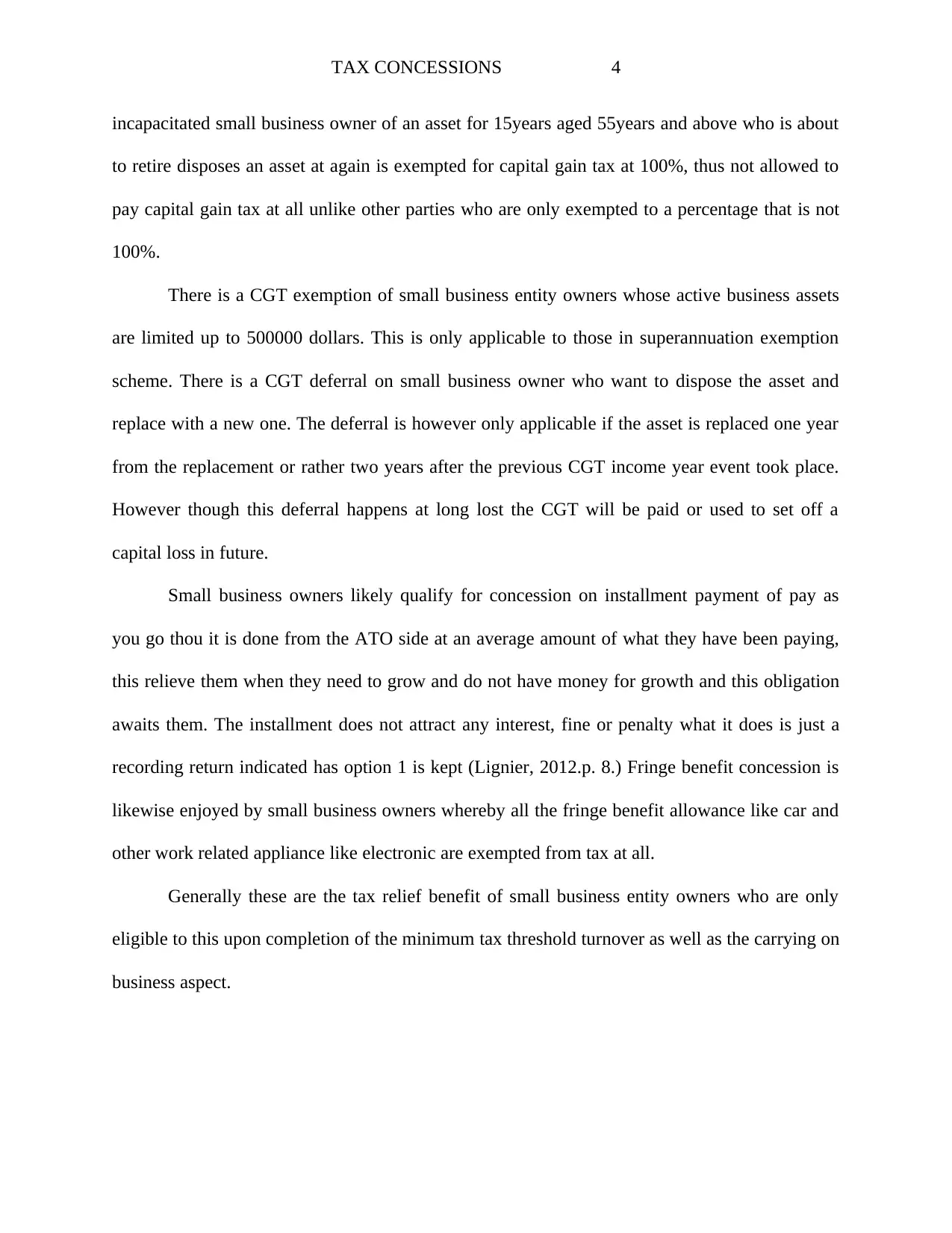
TAX CONCESSIONS 4
incapacitated small business owner of an asset for 15years aged 55years and above who is about
to retire disposes an asset at again is exempted for capital gain tax at 100%, thus not allowed to
pay capital gain tax at all unlike other parties who are only exempted to a percentage that is not
100%.
There is a CGT exemption of small business entity owners whose active business assets
are limited up to 500000 dollars. This is only applicable to those in superannuation exemption
scheme. There is a CGT deferral on small business owner who want to dispose the asset and
replace with a new one. The deferral is however only applicable if the asset is replaced one year
from the replacement or rather two years after the previous CGT income year event took place.
However though this deferral happens at long lost the CGT will be paid or used to set off a
capital loss in future.
Small business owners likely qualify for concession on installment payment of pay as
you go thou it is done from the ATO side at an average amount of what they have been paying,
this relieve them when they need to grow and do not have money for growth and this obligation
awaits them. The installment does not attract any interest, fine or penalty what it does is just a
recording return indicated has option 1 is kept (Lignier, 2012.p. 8.) Fringe benefit concession is
likewise enjoyed by small business owners whereby all the fringe benefit allowance like car and
other work related appliance like electronic are exempted from tax at all.
Generally these are the tax relief benefit of small business entity owners who are only
eligible to this upon completion of the minimum tax threshold turnover as well as the carrying on
business aspect.
incapacitated small business owner of an asset for 15years aged 55years and above who is about
to retire disposes an asset at again is exempted for capital gain tax at 100%, thus not allowed to
pay capital gain tax at all unlike other parties who are only exempted to a percentage that is not
100%.
There is a CGT exemption of small business entity owners whose active business assets
are limited up to 500000 dollars. This is only applicable to those in superannuation exemption
scheme. There is a CGT deferral on small business owner who want to dispose the asset and
replace with a new one. The deferral is however only applicable if the asset is replaced one year
from the replacement or rather two years after the previous CGT income year event took place.
However though this deferral happens at long lost the CGT will be paid or used to set off a
capital loss in future.
Small business owners likely qualify for concession on installment payment of pay as
you go thou it is done from the ATO side at an average amount of what they have been paying,
this relieve them when they need to grow and do not have money for growth and this obligation
awaits them. The installment does not attract any interest, fine or penalty what it does is just a
recording return indicated has option 1 is kept (Lignier, 2012.p. 8.) Fringe benefit concession is
likewise enjoyed by small business owners whereby all the fringe benefit allowance like car and
other work related appliance like electronic are exempted from tax at all.
Generally these are the tax relief benefit of small business entity owners who are only
eligible to this upon completion of the minimum tax threshold turnover as well as the carrying on
business aspect.
Paraphrase This Document
Need a fresh take? Get an instant paraphrase of this document with our AI Paraphraser
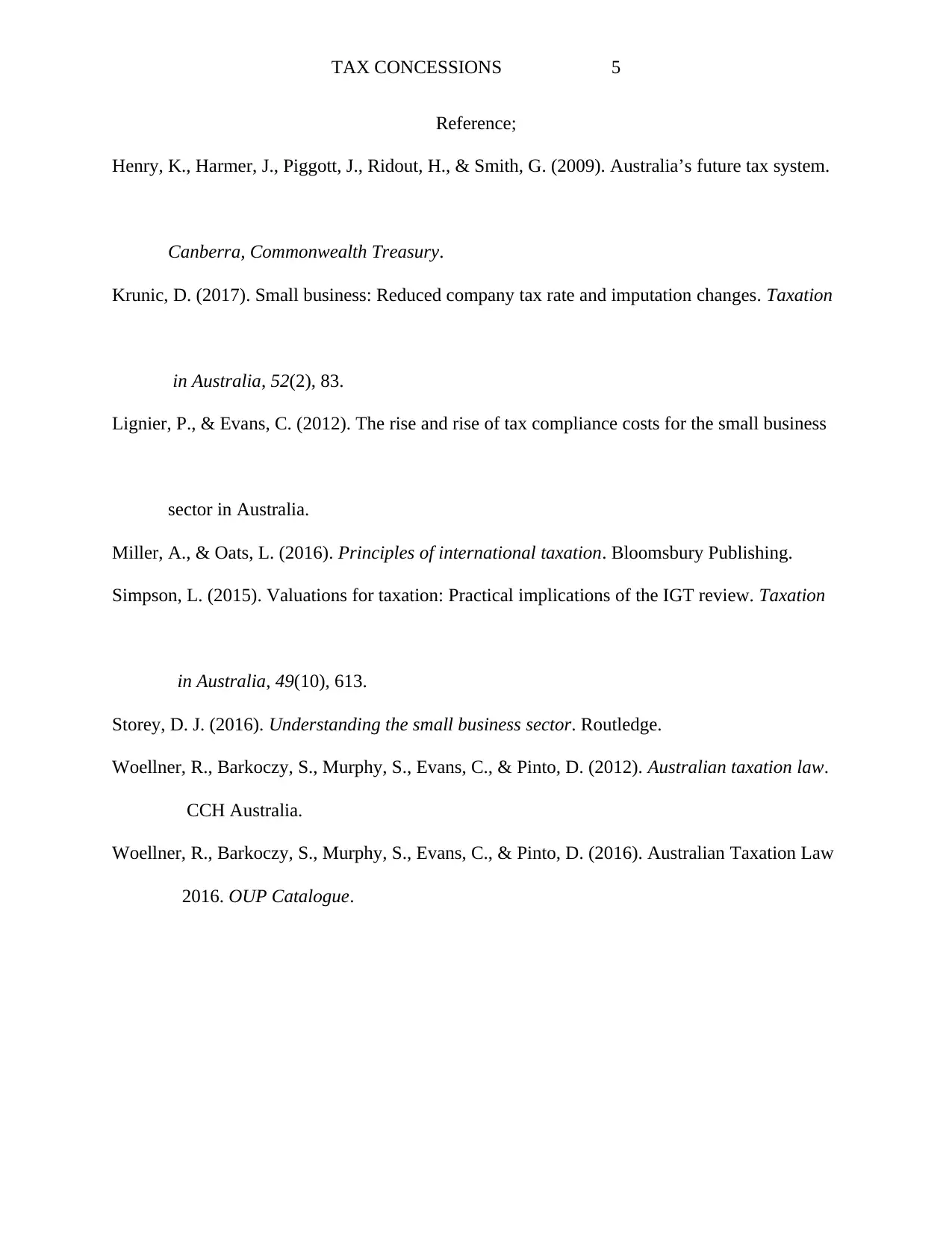
TAX CONCESSIONS 5
Reference;
Henry, K., Harmer, J., Piggott, J., Ridout, H., & Smith, G. (2009). Australia’s future tax system.
Canberra, Commonwealth Treasury.
Krunic, D. (2017). Small business: Reduced company tax rate and imputation changes. Taxation
in Australia, 52(2), 83.
Lignier, P., & Evans, C. (2012). The rise and rise of tax compliance costs for the small business
sector in Australia.
Miller, A., & Oats, L. (2016). Principles of international taxation. Bloomsbury Publishing.
Simpson, L. (2015). Valuations for taxation: Practical implications of the IGT review. Taxation
in Australia, 49(10), 613.
Storey, D. J. (2016). Understanding the small business sector. Routledge.
Woellner, R., Barkoczy, S., Murphy, S., Evans, C., & Pinto, D. (2012). Australian taxation law.
CCH Australia.
Woellner, R., Barkoczy, S., Murphy, S., Evans, C., & Pinto, D. (2016). Australian Taxation Law
2016. OUP Catalogue.
Reference;
Henry, K., Harmer, J., Piggott, J., Ridout, H., & Smith, G. (2009). Australia’s future tax system.
Canberra, Commonwealth Treasury.
Krunic, D. (2017). Small business: Reduced company tax rate and imputation changes. Taxation
in Australia, 52(2), 83.
Lignier, P., & Evans, C. (2012). The rise and rise of tax compliance costs for the small business
sector in Australia.
Miller, A., & Oats, L. (2016). Principles of international taxation. Bloomsbury Publishing.
Simpson, L. (2015). Valuations for taxation: Practical implications of the IGT review. Taxation
in Australia, 49(10), 613.
Storey, D. J. (2016). Understanding the small business sector. Routledge.
Woellner, R., Barkoczy, S., Murphy, S., Evans, C., & Pinto, D. (2012). Australian taxation law.
CCH Australia.
Woellner, R., Barkoczy, S., Murphy, S., Evans, C., & Pinto, D. (2016). Australian Taxation Law
2016. OUP Catalogue.
1 out of 5
Related Documents
Your All-in-One AI-Powered Toolkit for Academic Success.
+13062052269
info@desklib.com
Available 24*7 on WhatsApp / Email
![[object Object]](/_next/static/media/star-bottom.7253800d.svg)
Unlock your academic potential
Copyright © 2020–2025 A2Z Services. All Rights Reserved. Developed and managed by ZUCOL.





